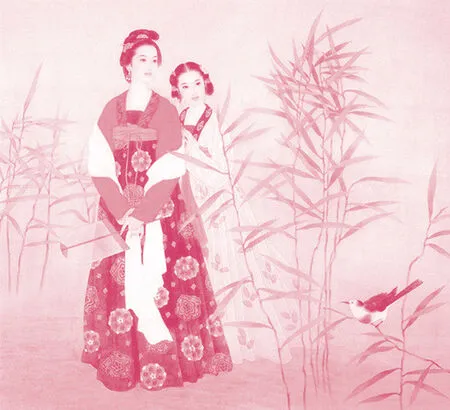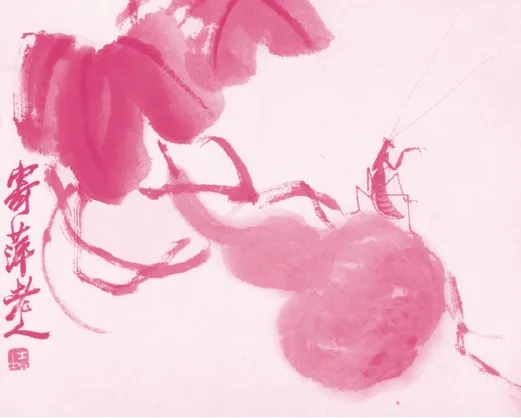Chinese Calligraphy and Painting (II)
文/雷蒙·道森 译/彭发胜
Chinese Calligraphy and Painting (II)
文/雷蒙·道森 译/彭发胜

A lthough an aesthetic of calligraphy developed early in China, there are few references to painting in the ancient literature. The brush had already been used in neolithic1neolithic新石器时代的。times for painted decoration on pottery, but the ancient literary sources of the Chou period still treat painting as a craft rather than an art. The six arts of antiquity2antiquity古;古老。were ritual, music, archery3archery射箭。 4 charioteer驾双轮马车的人。, charioteering4, calligraphy, and numbers, and so did not include painting, although later writers emphasized the close relationship between calligraphy and painting and their common divine5divine神的;神圣的。origin. Although painting had a somewhat lowly status, a craft which employed the same tool as the scholars used was bound ultimately to6be bound to注定。rise in general esteem. It was inkbrush painting which became the predominant7predominant主要的。form of painting in China,and everyone who became an ink-brush painter had fi rst been a calligrapher, so ink-brush painting was automatically a craft of the educated elite.

[2]The influence of calligraphy on this art may be seen in several ways.Firstly, the brushline was considered all-important, and what critics looked for in paintings more than anything else was that vigour of brushstroke which was the consequence of the artist’s calligraphic training. Another highly prized aspect of skill with the brush was the method of rendering8render表现;描绘。third dimension by varying thickness in the brush-stroke. This technique was already in use as early as the second century AD, and it was to become one of the important devices for indicating depth, another being variation in the ink tone, so that paler, more watery ink was used to render hazier9hazy朦胧的。, more distant objects. Rapidity, indeed spontaneity10spontaneity自发性;自然。,in the brush-stroke was another ideal which sprang from11spring from起源于,发源于。painting’s close kinship with calligraphy, for just as we write automatically, without thinking of the strokes as we form them, so it was thought that ideally one should be able to paint spontaneously. This rapidity and spontaneity of execution could make the appreciation of Chinese painting a ‘quasi-kinesthetic12quasi准的;类似的。kinesthetic动觉的;肌肉运动知觉的。experience’,as Cahill calls it when describing the paintingTwo Minds in Harmony, in which the vigorous movements of the painter are clearly re fl ected in his work,with black blobs13blob(黏稠的) 一团;(颜色的)一小片。where his brush has rested, and trailing14trailing被拖动的;蔓延的。streaks from the separate hairs of the brush as it moves swiftly across the paper. Because the brush-stroke was considered of primary importance, painting in colours came to be regarded as inferior.
[3]Secondly, the very satisfying sense of composition which is characteristic of much Chinese painting may also spring from the painter’s initial training in disposing elements in space in the writing of characters and in placing them in relationship to each other.
[4]Thirdly, certain subjects and motifs obviously lend themselves more readily to calligraphic treatment than others. As the eleventh-century art historian Kuo Jo-hsu wrote in hisExperiences in Painting, ‘in depicting drapery15drapery垂褶;布料。folds and trees one’s use of the brush will be of exactly the same sort as in calligraphy’. Later, especially in the Yuan Dynasty, bamboo painting became a major genre, in which the resemblance16resemblance相似之处。to calligraphy is most clearly marked. Eventually there were traditional brush-stroke conventions,categorized in calligraphic terms, which became standard elements of the reper-toire17repertoire(某人的)全部才能。of Ming painters and were listed and illustrated in painting manuals in the seventeenth century, the most famous of which was called thePainting Manual of the Mustard Seed Garden.The publication of such manuals inevitably gave the false impression that Chinese painting is a matter of assembling stereotyped18stereotyped老一套的。formulae19formulae程式;定则。.
[5]Fourthly, there is in Chinese painting a strong tendency to abstraction20abstraction抽象概念。conditioned21condition决定;以……为条件。by the abstract nature of the calligraphy which is so closely related to the painter’s art. This seems to be in con fl ict with the powerful basic motivation of depicting nature realistically,to make it seem as if one were actually there, which many painters and critics expressed; but this realistic purpose itself naturally developed into a desire to go beyond producing a likeness of one particular mountain and capture on paper the essence of mountainness.The important Ch’ing Dynasty painter and art historian Tung Ch’i-ch’ang did much both in his writings and in his art to turn painting into an abstract medium like calligraphy. His attitude is summed up in the maxim: ‘If one considers the uniqueness of scenery, then a painting is not the equal of real landscape. But if one considers the wonderful excellence of brush and ink, then real landscape can never equal painting.’ But at the same time this abstraction was not felt to be a move away from realism. Rather the painter achieved a greater sense of realism because in the very act of painting he felt the physical energy of the things he was painting; and instead of merely seeing and describing trees and rocks, he acts out their characteristics as he works. Chinese painting never totally abandoned reality for abstraction.Just as the written character, in however bizarre22bizarre奇异的(指态度、容貌、款式等)。a hand, must bear some resemblance to the standard script, so the painting would have appeared totally meaningless if it had been completely divorced from reality.
[6]Once paintings had become as strongly calligraphic as they were in the Yuan period, it was a natural development that real calligraphy should play a fully integrated23integrated各部分密切协调的;完整统一的。part in the picture. Calligraphy appears on the earliest extant Chinese paintings to describe what is being illustrated but it was only gradually that the subtle technique of making it an integral24integral不可或缺的。part of the composition was developed. The cultured25cultured有修养的;文雅的。amateurs who dominated the painting tradition in late imperial times were poets as well as painters, so it was natural that they should reinforce the sentiment26sentiment情绪;情操。of the painting with an appropriate poem written in beautiful handwriting which fi tted in well with the composition as a whole.The empty space in the composition ceases to be sky or rock, but is an area which can be filled by a poem just as legitimately27legitimately合理地;正当地。as by any other creation of the calligraphic brush which the Chinese painter wields28wield挥,操,使用(武器、工具等)。.
[7]So the history of painting in China is not so much a matter of the exploration of the physical world as the development of a brush repertoire for exploring that world. The brush-stroke is the central theme in Chinese painting,and one theoretical treatise29treatise论文;专著。opened by saying that the single brush-stroke was‘the origin of all existence and the root of the myriad30myriad无数的;种种的。phenomena’. Just as it was believed that the hexagrams31hexagram六角形;卦。in theBook of Changes, which were widely used for purposes of divination32divination占卜。, were abstractions of natural phenomena, so it was felt that brush-strokes were not merely a depiction of an object’s external appearance, but were an abstraction of its essential vitality. Brush-strokes seemed to stand for the inner structure of rocks as well as to imitate their outward appearance. ■
书法艺术美学在中国发展得很早,而在中国古代文献中提到绘画的却很少。在新石器时代,毛笔已经用来绘制陶器图案,但在周代典籍中,绘画仍被当作一门技艺,而非艺术。虽然后来的作者强调书法与绘画之间的密切关系以及两者共同的神性起源,但是古代的礼、乐、射、御、书、数六艺并不包括绘画。尽管绘画的地位稍低,但由于这门技艺的工具就是文人们写字用的毛笔,光凭这一点,最终必将提高人们对绘画的尊重。中国画以水墨画为主,每一位水墨画家首先必须是书法家,所以水墨画自然成为文化精英的技艺。
[2]书法对绘画的影响见诸于几个方面。首先,毛笔画的线条被认为至关重要。鉴赏家在画作中首先看重的是毛笔笔画的气势,而这一点则来自画家的书法训练。另一种运笔技巧也十分为人所看重,即通过笔画的粗细变化而产生立体感。这种技法早在公元2世纪就得到运用,后来成为表现景深的重要手段之一。另一种手段是墨色的浓淡变化,用稀释的淡墨表现朦胧的远景。运笔迅捷,不假思索,这是书画之间密切关系带来的另一种艺术趣味。就好比我们写字时并不想到笔画,但笔下的文字自然成形。因此,理想情况下,画家在作画时应该做到不假思索,恣肆洒脱。这种恣肆洒脱、运笔迅捷的艺术手法,让中国画的欣赏成为一种“准动态的体验”。这是高居翰在描述石恪《二祖调心图》时提出的。画家运笔时那种灵动飞扬的气势在画作中清晰可见:画笔停歇之处墨迹泛泛,而画笔在纸面一挥而过时,散开的毛毫曳出缕缕细线。正因为笔法至关重要,色彩画也就被认为低于水墨画。
[3]其次,构图优美是大多中国画的特点,这也许得益于画家在学画前的书法训练。写字时不但讲究每个字的间架结构,而且字与字之间也要求布局得宜。

郭若虚作品
[4]第三,某些景物和主题显然更适于以书法手段来处理。11世纪的艺术史家郭若虚在他所著的《图画见闻志》中写道:“画衣纹林木,用笔全类于书。”后来,特别在元代,竹画成为中国画的主要题材。书画之间的相似性在竹画中表现得最清楚不过。最终便形成了传统的笔墨规矩,这些规矩拫据笔法的不同分门别类,成为明代画家全部技法的准绳。在17世纪,这些笔墨规矩在绘画指南中通过图谱逐类得以阐明,其中最著名的就是《芥子园画传》。但这一类绘画指南的刊印不可避免地给人一种错误的印象,即中国画只是一些刻板程式的拼凑而已。
[5]第四,中国画具有强烈的抽象化倾向,而这又取决于和绘画艺术密切相关的书法的抽象性。抽象似乎与如实摹写自然的根本动机相矛盾。许多画家和鉴赏家都主张写实,以使观者有身临其境之感;但是,写实的主张自然发展为对象外之旨的渴望,画家不只是为了表现一座山的外观,而是要把他所领悟的山性真髓反映在画纸上。明代重要画家、艺术史家董其昌通过他的绘画和文章,力促绘画成为书法那样的抽象艺术。他认为:“以境之奇怪论,则画不如山水;以笔墨之精妙论,则山水绝不如画。”然而,这种抽象性却并没有脱离写实风格。恰恰相反,画家借此获得了更强的真实感,因为在他运笔作画之际,体会到所画对象的自然能量。画家并非单纯地观看并摹写树木和岩石,而是运笔皴染之间传达景物的神髓。中国画从来不曾为了抽象而全然拋弃真实,正像书法家的字不管如何龙飞凤舞,同正楷总有几分相似。因此,一幅画如果完全背离真实,就显得毫无意义。

[6]当绘画变得十分书法化时,比如在元代,真正的书法自然就融入画面,成为绘画不可或缺的部分。中国画上的书法题字,现存最早者描述的是画面的内容。然而,将书法融入绘画的精妙技巧却经历了长期发展才得以完善。在帝制后期,文人雅士统治着画坛,他们既是画家,又是诗人,自然喜欢题诗以添画趣。题画诗书写优美,与画面整体构图相得益彰。画面的空白处用来题诗,而不再以天空或者山岩来填补,其合理性等同于中国画家笔下的任何其他创作。

[7]由此可见,中国画史的实质,与其说是对外部世界的探索,不如说是为了探索外部世界而发展出的诸多笔墨技巧。笔法是中国画的核心内容。石涛《画语录》开篇写道:“一画者,众有之本,万象之根。”《易经》的卦象曾广泛用于占卜,据认为是自然现象的抽象表达。同样,笔法不仅可以摹写景物的外观,还可以抽象传达其内在气韵。除了摹仿山岩的外形,笔法似乎还体现了岩石的内在结构。 □
中国书法与中国画(下)
ByRaymond Dawson

